Fluxus and the artwork multiple
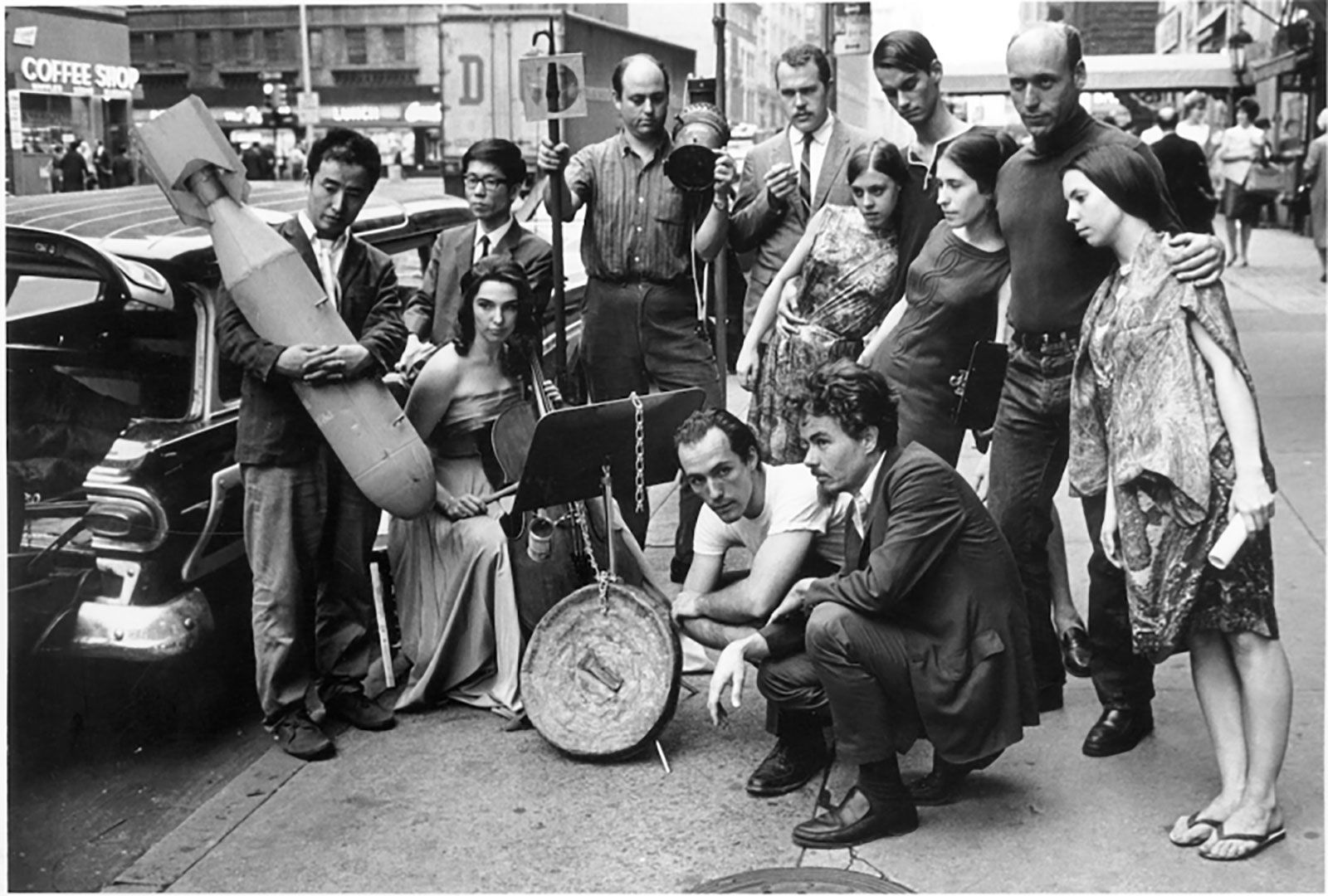
Peter Moore – Publicity photograph for 3rd Annual New York Avant-Garde Festival, August 26, 1965. Left to right: Nam June Paik, Charlotte Moorman, Takehisa Kosugi, Gary Harris, Dick Higgins, Judith Kuemmerle, Kenneth King, Meredith Monk, Al Kurchin, Phoebe Neville.
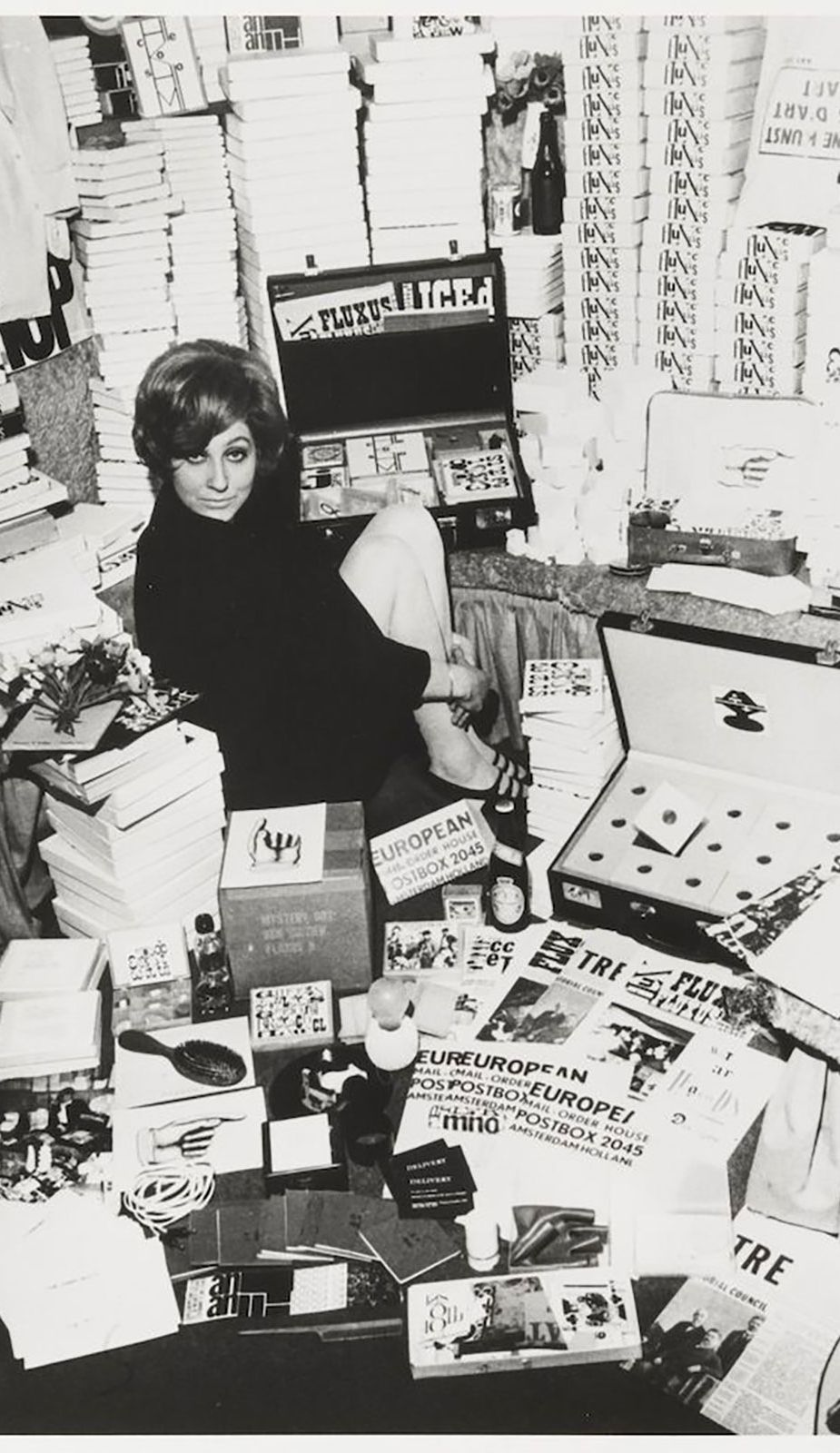

Willem de Ridder’s Mail Order FluShop, Amsterdam, with Dorothea Meijer, winter 1964-1965.

George Maciunas, «Fluxkit», 1964 © George Maciunas.
This week Cardi Gallery invites you to explore an unparalleled selection of Fluxus editions and ephemera made available through the gallery’s longstanding collaboration with The Archivio Conz. As one of the most defining art movements of the 20th Century, Fluxus originated from the late 1950s, parallel to the development of the Happenings. The group has since been heralded as one of the most important Western art movements within the avant-garde and furthermore as an essential harbinger of today’s postmodernist multi-media art. This post explores the origin of the artwork multiple and further introduces three Fluxus editions that represent some of the group’s main subjects such as language, geography and music.
Many attribute the “Fluxus Internationale Festspiele Neuester Musik”, a three-week-long music festival in Wiesbaden, Germany in 1962 as the catalyst for the growing Fluxus- Ideology. Organised by artist George Maciunas, founder and central coordinator of the movement, the musical event became central to an emerging conceptual manifesto that would trigger a series of related Fluxus events in Europe. Fluxus would later be defined as the first transatlantic artistic movement, bringing together artists such as Joseph Beuys, Nam Jun Paik, John Cage, Ay-O, Charlotte Moorman, Daniel Spoerri, Yoko Ono and Robert Filliou. Similarly to the Dadaists and Futurists, followers and members of Fluxus intended to challenge the status quo established by museums. They did not believe in the authority of art institutions to determine the value of art, nor did they recognise art education as essential to be able to view or understand a work of art. In this way, the group’s activities had a profound influence on the nature of art production, as well as the development of a new conceptual effort to “promote a revolutionary flood and tide in art, promote living art, anti-art.” (George Maciunas).
Originating from the Latin word “flowing”, the term Fluxus, assigned by Maciunas, embodied a democratic approach to art-making. Subverting predisposed notions of art, the group explored new mediums such as music, heavily influenced by John Cage, poetry, print-making and performance. A never before seen effort to collaborate across different genres and between different nationalities explored artistic collaboration as a political statement. Fluxus became a radical force against the bourgeoisie of the art world as proclaimed in Maciunas’s 1963 Manifesto: “Purge the world of bourgeois sickness, ‘intellectual,’ professional & commercialized culture, PURGE the world of dead art, imitation, artificial art, abstract art, illusionistic art, mathematical art, — PURGE THE WORLD OF ‘EUROPANISM’!”
While members of Fluxus did not consider themselves as fixed entity attributed to an art movement, nor did they advocate for any specific artistic style, the collective aimed to collaboratively develop alternative spaces and practices that closed the gap between art and the everyday. Re-evaluating the accessibility of art, meant recognising its commodification through the museums and galleries. Naturally an anti-commercial movement, Fluxus members retaliated by creating opportunities to utilise capitalistic structures for their anti-establishment gain. This development was furthermore rapidly influenced by the growing art medium “Mail art”, a movement concerned with the creation of small scale artworks that were created through the distribution via the postal service. Within Fluxus however, the development of the edition or multiple stems partly from an effort to immortalise the group’s many ephemeral performances.
At the same time as American and European publishers started to commission and distribute non-traditional art mediums, Fluxus founder George Maciunas envisioned so- called “Fluxshops”. Tiny retail spaces made accessible for the general public, in the same way, any other hardware store would be. Meant to be informal the presentation of the products on sale was presented in a non-exhibition-like manner, reducing the work of art to an object. While this concept highly supported the collective aim of self-authorship for the artists, it also further informed the discourse around material and concept. Objects created were meant to be interacted with, touched, held and read by the viewer. New York’s “Flux-Hall” on 359 Canal Street, became an active retail space open with regular opening hours during the day, and at night transformed into a meeting place for performances and discourse.
“The fact that art was for sale not in a museum or a gallery anymore, but as a Mail Order project! […] It was a work itself and I’m glad it stayed together and didn’t become commercial. I always liked that Fluxus wasn’t official. It wasn’t museum or gallery culture.”
(Willem de Ridder, 2002)
“The Fluxkit”, a portable suitcase containing a variety of small products, produced by the Fluxus members, remains known as one of the more elaborate and more remembered examples of the inventory presented at the “Fluxus European Mail-order Warehouse/ Fluxshops”. About the production of “Fluxkits”, artist and member of Fluxus, Alison Knowles explained that they served the purpose to present and contain various mediums by different artists. The latter wanted to break away from any traditional medium further. Knowles, for example, produced a miniature version of canned literature, containing nine beans for the 1964 Fluxkit.
Italian collector and arts patron Francesco Conz was an acclaimed supporter of various avant-garde movements of the 1970s. As a leading publisher of art ephemera and art multiples, Conz has been attributed to have immortalised a vast selection of works across a range of movements and groups such as Fluxus, Viennese Actionist, ZAJ, Concrete Poetry, Gorgona Group and Lettrist. The Archivio and Edizioni Conz exists to preserve his legacy and promote the vast collection of works ranging from painting, drawing, photographs, musical scores and machines, poems, sculptural works, relics from performances and ephemeral to other genre-crossing collectables. Cardi Gallery is proud to present a selection of Fluxus works on view per requests or the gallery’s Artsy page.
Charlotte Moorman, Select Images of a performance of Giuseppe Chiari’s “Per Arco”, Valpolicella, 1983-1985
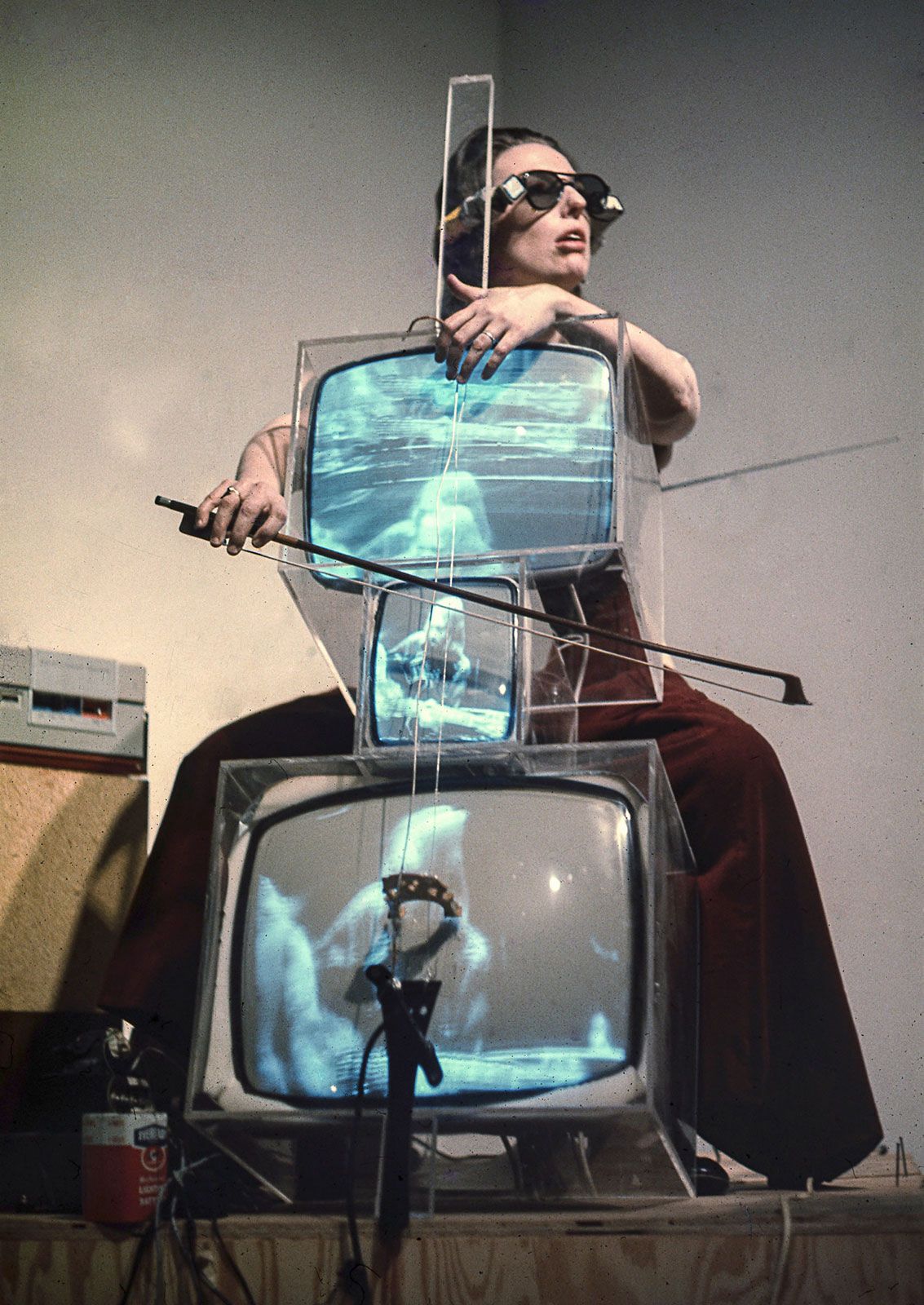
Charlotte Moorman performing in 1971. Takahiko Iimura.
Artist and Fluxus member Charlotte Moorman became a central figure of the New York avant-garde in the 1960s and 1970s through her experimental music collaborations with fellow Fluxus member Nam June Paik. Often playing the cello partly or fully nude on stage, the media gave her the title of “topless cellist”, a somewhat derogatory term that often reduced her to a decorative accessory to Paik’s highly acclaimed stage performances. Moorman’s legacy has been re-evaluated in recent years through the dedication of posthumous exhibitions that have since highlighted her achievements beyond the scope of media outrage. Amongst her most significant contributions to the art world is the production of fifteen editions of the “New York Avante-Garde Festival”, a large scale festival held in New York in between the years of 1963 and 1980. While Moorman’s oeuvre, like many Fluxus artists, is impossible to attribute to an artistic category, her wide-reaching influence within the avant-garde community at the time, made her a boundary-crossing champion of Fluxus.
The portfolio “Select Images of a performance of Giuseppe Chiari’s “Per Arco” (1983-1985), contains photographs of Moorman’s cello performance as well as an introductory text. Like many other Fluxus performances, this specific event was organised under the patronage of Francesco Conz, who invited the artist to a quiet vineyard in Valpolicella, Italy. There, Moorman performed the musical score “Per Arco” created for her by Italian composer Giuseppe Chiari. Reminiscent of the sounds of the Vietnam war circulating through the media in the mid-1970s, the score was constructed through audio recordings of machine-gun fire and detonating bombs. Listening to the recording Moorman then played the cello in response to what she heard. Her emotional reaction is captured through a series of photographs that have immortalised the performance and are featured in the portfolio published by Edizioni Conz in Verona in 1983.

Peter Moore’s performance photo of Charlotte Moorman and Nam June Paik, 1965. All Rights Reserved, Barbara Moore/Licensed by VAGA, New York, NY and Paula Cooper Gallery, NY.

Charlotte Moorman, Select Images of a performance of Giuseppe Chiari’s “Per Arco”, Valpolicella, 1983-1985.
Eugen Gomringer, Untitled, 1955-1990
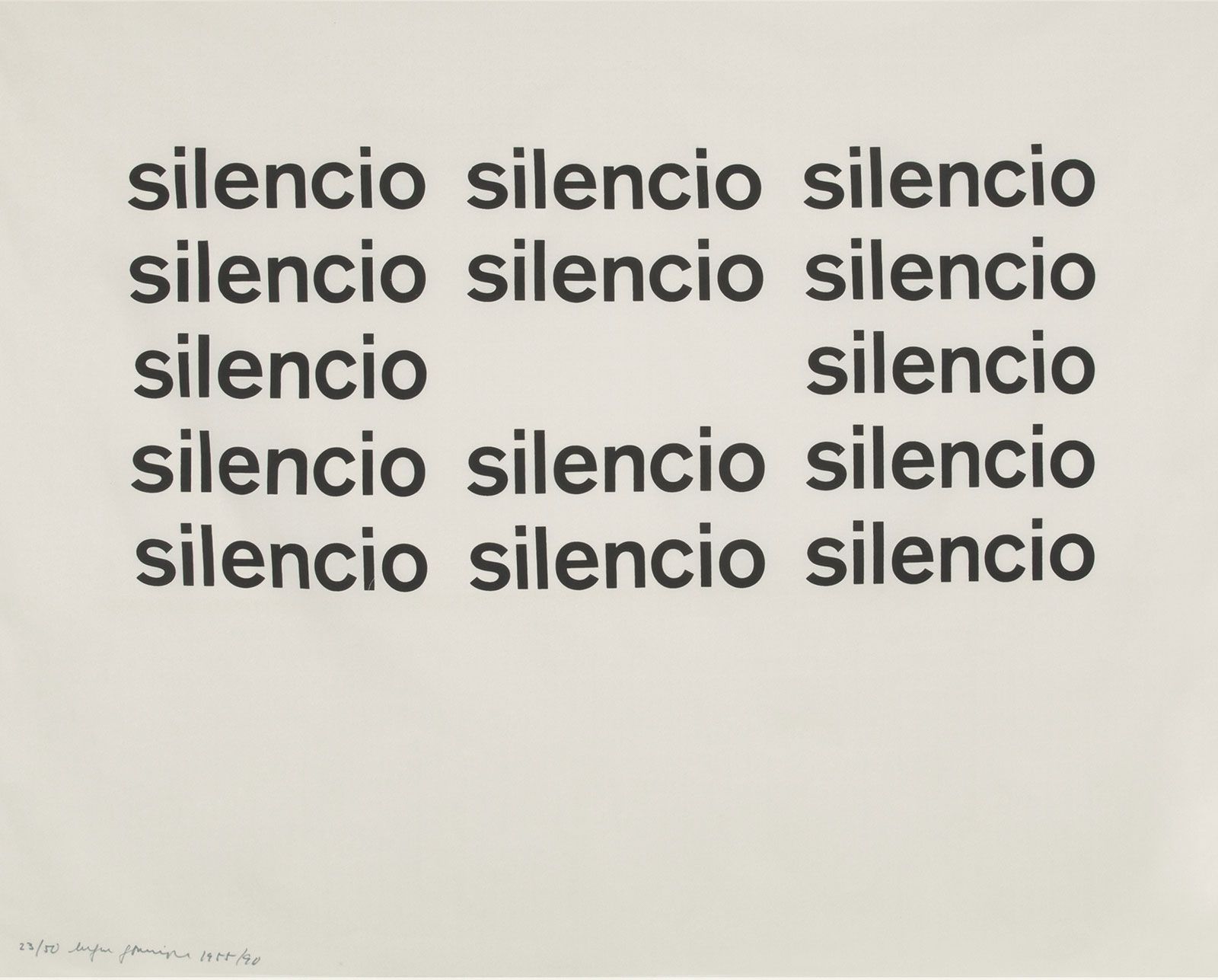
Eugen Gomringer, Untitled, 1955-1990.
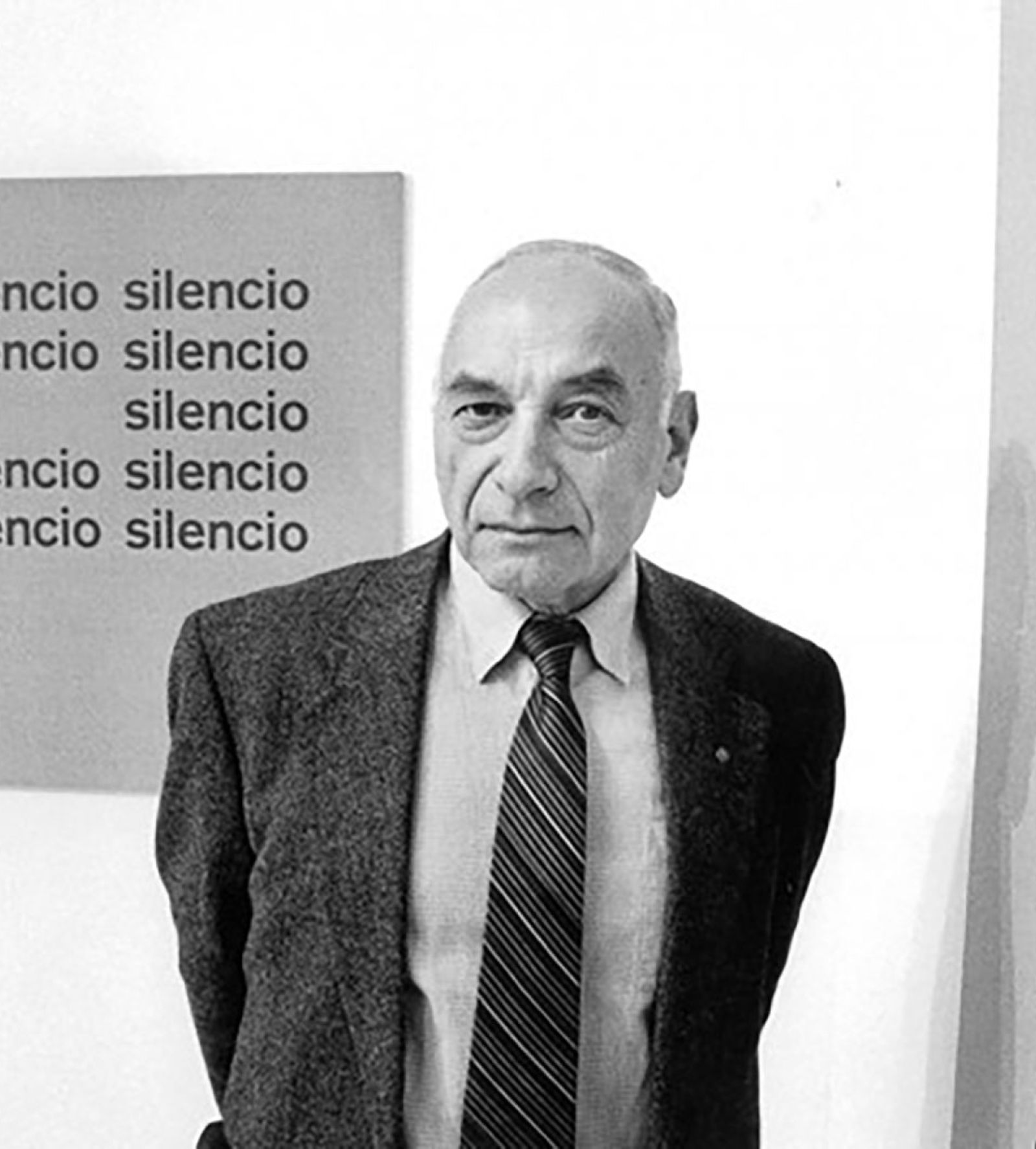
Eugen Gomringer with Untitled, 1955-1990.
Bolivian-born German Fluxus artist Eugen Gomringer is the main representative and founding member of the Concrete Poets, whose movement was closely linked to Fluxus. His poems are still being recited today, as essential literature in schools around the world today. Following his studies in economics and art history at the begging of the 1950s, Gomringer published the magazine “Spriale” together with Dieter Roth. Since this endeavour he has been consistently collaborating with artists inside the Concrete Poetry group as well as outside of it, editing artist’s books or essays. Gomringer was well connected with many artists from the Fluxus group, but moreover shared a long-term friendship and ongoing collaboration with Francesco Conz and his organisation today.
Gomringer’s “Silencio” poem, was published amongst the artist’s first collection of Concrete Poetry titled “Konstellationen”, which translates to “Constellations”, as early as 1953. The German version of the poem “Schweigen” has since been included in the anthology of the 100 most famous German poems. As a quintessential example of Concrete Poetry, “Silencio” represents the typical stylistic and linguistic aims of the movement. The blanks canvas features a frame formed from the repetition of the word “silencio”, creating a blank space in the middle of the block. Strongly informed by the linguistic minimalism of Concrete Poetry and the visual minimalism of Concrete Art, Gomringer’s “Silencio” aims to proclaim a reduction of language in the context of our present, characterised by an abundance of communication. The further political subtext of this kind of poetry reveals the preoccupation with silence as a response to post-war Germany. Alluding to the impossibility of communicating the profound trauma of the Holocaust, Gomringer’s poetry offered a brutal confrontation with the silence of the German society.
Dick Higgins, Europe – War (Blue), 1988
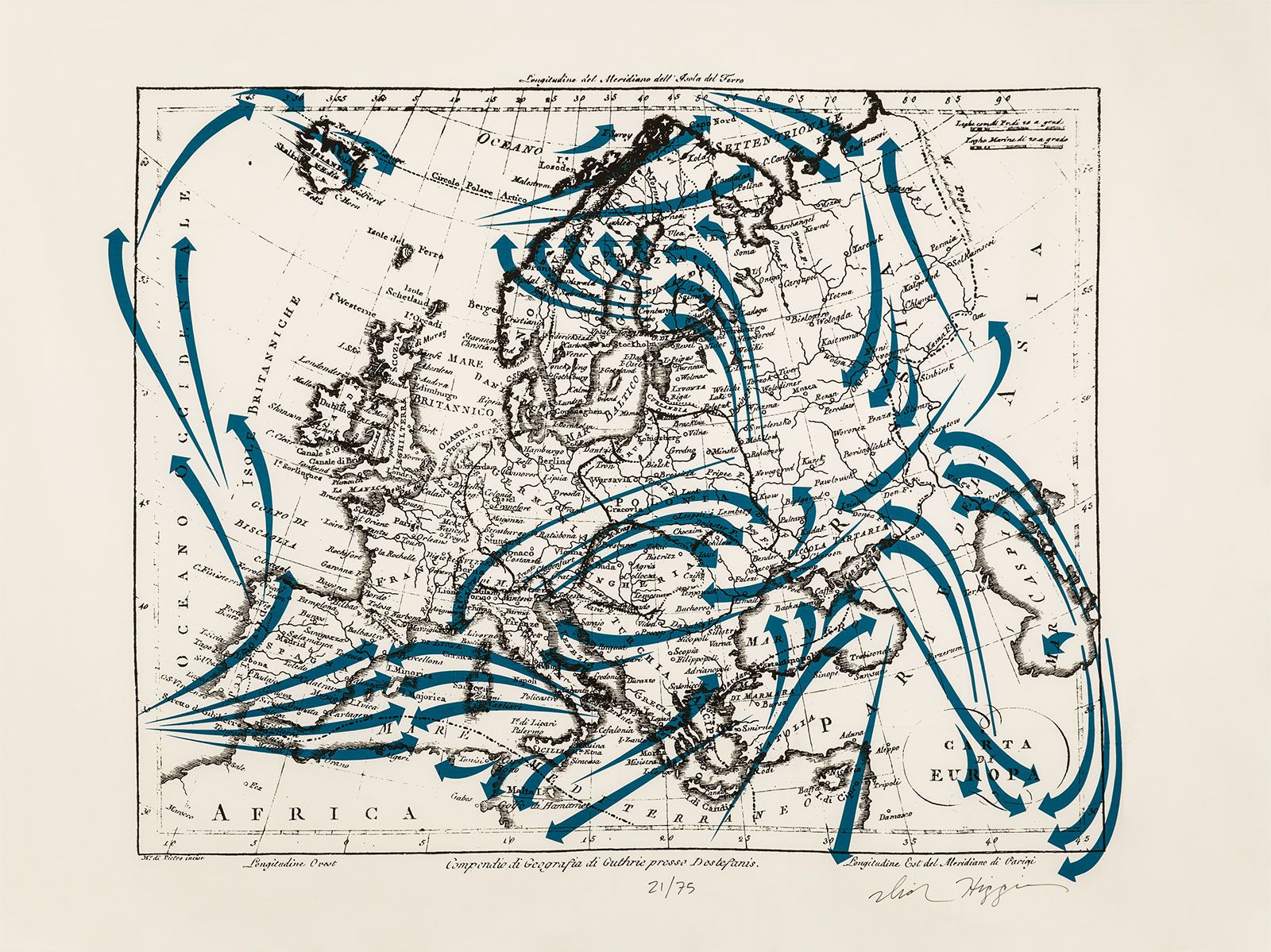
Dick Higgins, Europe – War (Blue), 1988.
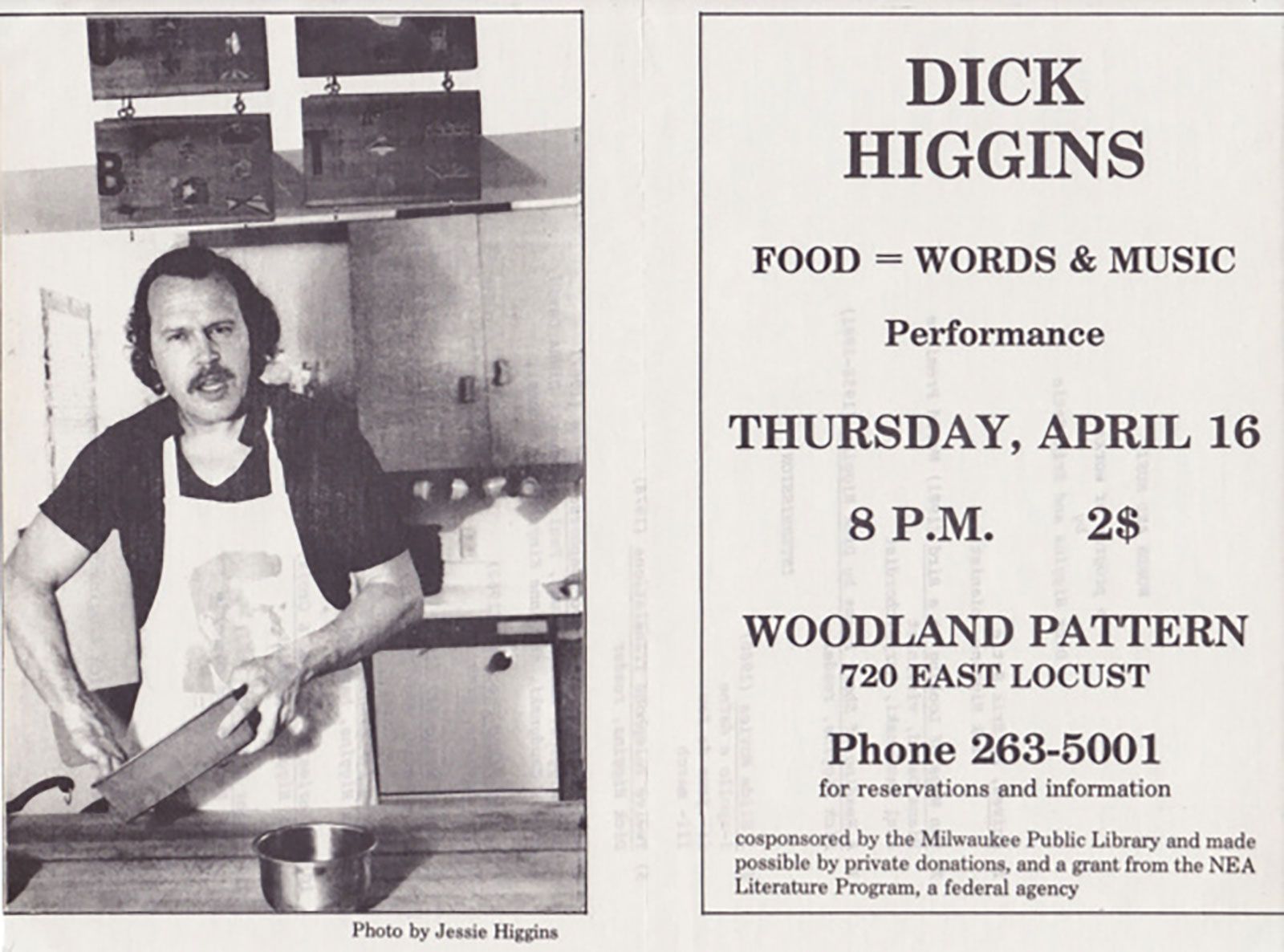
Flyer for “Food = Words & Music,” 1987 a performance by Dick Higgins at Woodland Pattern, Milwaukee.
Central to the movement, artist and Fluxus member Dick Higgins coined the term Intermedia, a description to emphasise the multidisciplinary nature of the different artistic activities within Fluxus. Fundamentally, for the Fluxus members, the artwork that bridges two or more media held a higher value than the work which appropriated only one medium. The “Intermedia: Chart”, a Venn diagram, remains an essential product of art theory derived from the progressive Fluxus practice that has shaped our collective understanding of the dynamics of conceptual art forms today.
Higgin’s Europa series, commissioned by Francesco Conz in 1988, was part of an extensive series of map paintings that interrogated geographical representations based on political, historical and geographical dynamics present at the time. Boldly coloured arrows were superimposed onto current or historical maps, outlining specific tensions such as in Europe – War (Blue), 1988, the dynamics of war. The utilisation of the map as subject and medium was an established practice within Fluxus. Loosely referred to as “Fluxus Geographers” artists such as Dick Higgins, Mieko Shiomi, George Maciunas, Robert Watts and Walter Marchetti explored the medium and utilised it to represent one of the principles of the movement, which is the promotion of national fluidity. After all, Fluxus aimed to present a new world order, and thus the reconfiguration of both contemporary and historical maps came as no surprise.
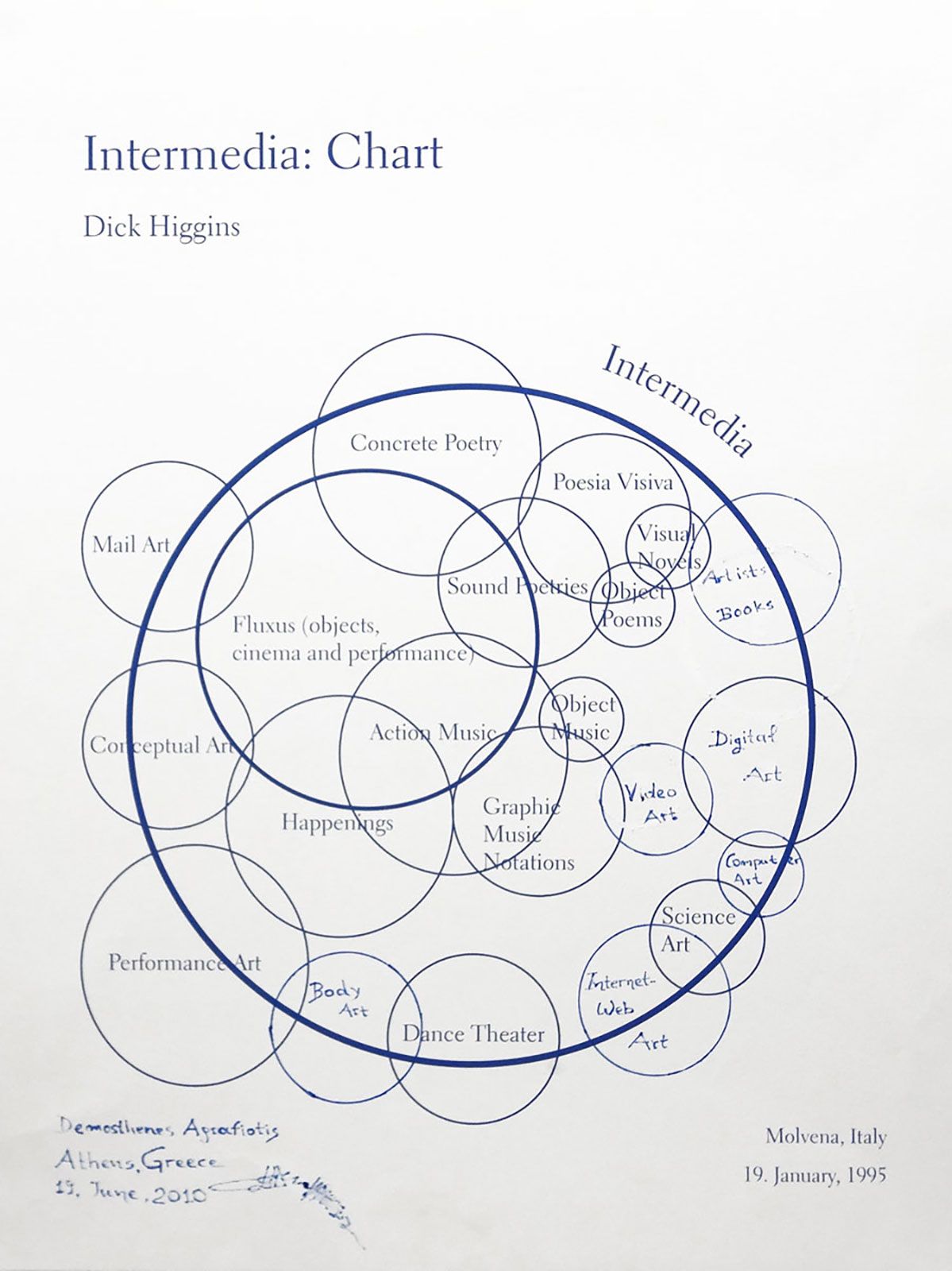
“Intermedia Chart” by Dick Higgins -Variation by D. Agrafiotis.